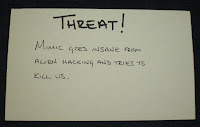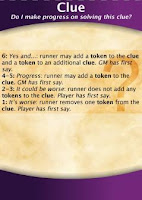 This is the second part in an ongoing series about Earthdawn.
Introduction and
Index.
This is the second part in an ongoing series about Earthdawn.
Introduction and
Index.
The information presented here has been updated for Earthdawn Fourth Edition (ED4).
The path these posts take may seem haphazard, but there is a method to my madness! To continue the trend of taking good advice when I hear it, the plan is to write about the aspects of Earthdawn that I find the most compelling, that are always in my head. To really engage in that, there is some groundwork that needs to be laid first. A subtle aspect of Earthdawn is how intertwined the various elements are. Each topic requires an understanding of attendant concepts and separating them can be tricky. Where this is going: if something doesn't make sense, leave a comment and I will provide some context and try to ensure it is covered sooner than later. The mechanics will be expressed from the perspective of Earthdawn Third Edition and Fourth Edition (ED3 and ED4 respectively) since it is currently they are the most recent editions. Changes from previous editions can be found here: 1E, 3E and Revised.
 Magic is everywhere in Earthdawn; it pervades every aspect of the system and setting and is awesome. Magic is based around the concept of threads, it is the basic unit in which magic is expressed. Using magic involves weaving these Threads, and anything that is permanently magical has a pattern, which generally means that it has a Name. These are important concepts and will be covered in detail another time. For now: magic involves weaving threads to patterns which have Names.
Magic is everywhere in Earthdawn; it pervades every aspect of the system and setting and is awesome. Magic is based around the concept of threads, it is the basic unit in which magic is expressed. Using magic involves weaving these Threads, and anything that is permanently magical has a pattern, which generally means that it has a Name. These are important concepts and will be covered in detail another time. For now: magic involves weaving threads to patterns which have Names.
Every PC is an adept, someone that can use magic, and every adept expresses their magic through their discipline. A discipline is an archetypal concept that has developed a Name and a pattern, examples include the Swordmaster, Warrior, and Weaponsmith. They are the foundation of every Earthdawn character, which is hardly unique to any class-based system. What makes a discipline different is how it is addressed within the system and the setting. By following a discipline the adept is aligning their pattern with the pattern of their discipline. The threads to the discipline pattern take the form of talents (abilities powered by magic).
Like many things in Earthdawn, disciplines exist in and out of game. If you were to inform another Namegiver that you are a Weaponsmith, this would communicate something specific and intrinsic about you. Telling them you are a Swordmaster versus a Warrior would communicate something very different. The Names are more than just adjectives. Each discipline is also a philosophy, a way of life - truly requiring dedication and focus to follow. Each expression of that philosophy is personal, though often passed from master to apprentice. What this means is that there are certain behaviors which are expected and those which are largely prohibited. Falling outside of these expectations will put the adept into a crisis where their talents will begin to fail them. This is a big deal and will require sacrifice of some kind on the part of the adept, a re-dedication to their discipline and what it means.
 Let's take a look at Swordmasters and Warriors to get something of a feel for these differences and what they mean. Both are combat disciplines, but how they go about that and how they see the world is different. The Swordmaster dedicates themselves to the blade, sometimes even one specific weapon, and views life as an adventure, a story yet to be told. They tend to be full of energy and excitement, dedicated to living each day to the fullest and getting in the most fun kind of trouble. Warriors tend towards being more solemn and it is not uncommon for them to gather in monastic brotherhoods. They are more interested in camaraderie than bragging rights, and victory over panache. A Swordmaster that engages in dishonorable combat or without embellishment is in danger of a crisis. A Warrior that betrays their comrades or fails to eliminate a traitor would be in similar danger. This is an example of how these Names, and Names in general, within Earthdawn have meaning, and those meanings are important.
Let's take a look at Swordmasters and Warriors to get something of a feel for these differences and what they mean. Both are combat disciplines, but how they go about that and how they see the world is different. The Swordmaster dedicates themselves to the blade, sometimes even one specific weapon, and views life as an adventure, a story yet to be told. They tend to be full of energy and excitement, dedicated to living each day to the fullest and getting in the most fun kind of trouble. Warriors tend towards being more solemn and it is not uncommon for them to gather in monastic brotherhoods. They are more interested in camaraderie than bragging rights, and victory over panache. A Swordmaster that engages in dishonorable combat or without embellishment is in danger of a crisis. A Warrior that betrays their comrades or fails to eliminate a traitor would be in similar danger. This is an example of how these Names, and Names in general, within Earthdawn have meaning, and those meanings are important.
The measure of how aligned an adept is with their discipline is called their circle (virtually the same as a level) and those are divided more coarsely by tier (Novice, Journeyman, Warden, and Master). All of these, including talent ranks, are actual things within the setting. When I first encountered that so many years ago (so very many...) it was a breath of fresh air to me. The cagey dance around classes and levels had grown weary, how to explain your level and class while remaining in-character?
Digression aside, the greater your circle, the more overtly magical your abilities and the higher standard you tend to be held to within your discipline. However, with that experience comes a level of comfort and self-awareness. Through your discipline you understand yourself better and how your perspective can be altered to accommodate competing philosophies. Essentially you can add additional disciplines so long as your paradigm is accepting of the new path.
Given the inherent magical nature of each discipline, some traditional assumptions regarding areas of effectiveness are different. For example, the Warrior is an absolute beast in combat; nothing else can really compare. Spellcasters do not shine in a fight, at least not consistently. They are more likely to prey on the weaknesses of particular enemies, or support the more combat-savvy members of the group. It is outside of combat where their spells begin to carry the day. This explicit nature of what you see is what you get also works for me. There are very distinct cues that tell you what your character is about, however there are also very subtle ones that will guide you on how they work through their Talent interactions.
Here is a list of the core 15 disciplines and a brief description (full list here):
- Air Sailor: Deeply invested in the ideals of teamwork and civilization, these swashbucklers of the skies are consummate travelers. Abilities in combat and social settings, they are particularly team-oriented in their capabilities.
- Archer: Very focused with an emphasis in direction and vision in all things, they are the masters of missile weapons. Missile combatants with a number of perception/searching abilities.
- Beastmaster: Often attended by a collection of animals they share a bond with, they tend to find greater comfort in natural surroundings and are fierce unarmed combatants with their claws.
- Cavalryman: Deeply bound to their mount of choice, these mounted warriors are fearsome and varied. They heavily emphasize mounted combat with some social elements.
- Elementalist: Spellcasters that gain their power from manipulating the basic elements. They are more support-based than the other spellcasters.
- Illusionist: The most social of the spellcasters, they emphasize deception in their pursuit of truth. Tricky to master, but they have some of the most interesting spells.
- Nethermancer: Specializing in the magic of other planes, they are considered to be a little "off". Much of their magic is oriented towards undead, Horrors and Horror constructs, they tend to have the most combat applicable spells.
- Scout: Gathering information and blending into the surroundings, whether it be the city or wilderness, no one is their peer in this regard. While they can engage in archery, combat is not particularly an emphasis.
- Sky Raider: Ruthless sky pirates that favor strength and honor in all things. Typically, but not always trolls, very few are their peers in combat and none in sheer power. These guys base jump without a parachute onto other airships.
- Swordmaster: The classic swashbuckler, emphasizing swagger and style in all things. They favor a grand entrance and shun stealth. In addition they have excellent access to social and combat abilities. In combat they specialize in one-on-one confrontations and have a more complicated playstyle than most.
- Thief: Whether stealing out of greed or to teach a lesson about the attachment to material possessions, stealing is what a thief does. They fulfill all of the classic thief tropes: sneaking, traps, backstabbing, etc.
- Troubadour: Entertainers and scholars, they travel the land spreading knowledge and gathering the same. The most social Discipline and also the best access to information.
- Warrior: Often trained in monastic groups, they know all too well that violence is best used as the last resort, but are never afraid to do what is needed. Honor and loyalty are vital concepts and the understanding of death becomes important as comrades are claimed. All-around the most competent in combat, varied emphases depending on preferences.
- Weaponsmith: Often the central figure in any community, the Weaponsmith places a high value on the trust given to them in that role. They are relatively balanced in access to knowledge and social abilities, along with some combat options eventually. Their greatest contribution to any group is the ability to improve weapons and eventually gain access to spells and crafting magical items.
- Wizard: The classic spellcaster has a place, they emphasize knowledge over the others. Their spells are varied and often eclectic in application.






































